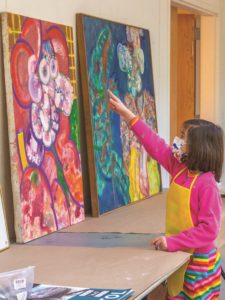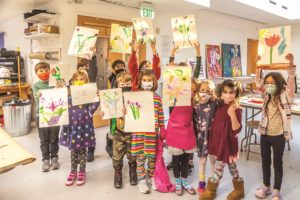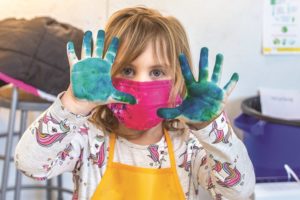“What do you see?” teacher Abraham Storer asks 15 eager young artists sitting on the floor, doodling in their sketchbooks. He points to some paintings by abstract expressionist Robert Beauchamp, who studied with Hans Hofmann in Provincetown during the 1950s.

Responses from young voices carry across the room:
“A dragon!”
“Ooh! A lion body with a bear head!”
“Flowers!”
The students are part of the Provincetown Art Association and Museum’s Little Artists program. The after-school winter session started on Feb. 8 and continues over six consecutive Tuesdays (it was delayed from a planned Jan. 11 start because of Omicron). There will also be sessions in the spring and fall. The program is free, thanks to an anonymous donor.
The students are split into two classes. Grace Emmet, PAAM’s curator of adult education, teaches students in preschool and Storer (who is also a freelance writer for the Independent) teaches students in kindergarten through second grade. PAAM’s Youth Education Coordinator Tessa Bry Taylor, teaching assistant Edwige Yingling, and 14-year-old student mentor Wilson Kerr-Havey assist in the two classes.
“We engage with local artists and learn about the Provincetown art colony over many generations,” says Taylor.
Storer focuses each week on a particular artist from PAAM’s permanent collection. “I love to have kids look at work and respond to it,” he says. “They have such fresh perspectives that are very different from the ways adults view art. They’re open, experimental, and they don’t have a lot of inhibitions about making things or jumping into different materials.”
Most weeks, the students complete a project within the hour-long class using a variety of media including drawing, painting, sculpture, and fiber.
Six-year-old Tommy Cook zeroes in on his Beauchamp-inspired figure. “It has the body of a hamster, the arms of a lion, the legs of an elephant, the head of a snake, and the scales of a fish,” he explains. He quickly draws a person next to his figure, “to show how big it is.”
Across the hall, 10 younger students hover around Emmet as she explains the process of eco-printing: using branches, acorns, and leaves to make impressions in clay.
“Imagine you’re an explorer,” she tells them. “What would you want to explore?” One student says she wants to explore “Provincetown,” then, more specifically, “the bagels of Provincetown.” Which bagels exactly? She doesn’t know.

“It’s funny to see how they’re making connections to the world, and how they’re really seeing it for the first time,” Emmet says. Her goal is to allow her students to focus on the process of making art more than the final product.
Dressed in aprons, the students are set loose on slabs of clay, bits of foliage, and tubes of orange, blue, green, and red food coloring. They wrangle their clay into balls, adding color and squishing them down on the table.
Four-year-old Willa Taylor chooses orange food coloring. Engrossed in the process, she reaches for the green tube, then quickly the blue. Soon, her hands are dark purple.
“Willa, remember when I said to use one drop of dye?” Emmet says. Willa, inspecting her hands, responds earnestly: “I only used two.”
Children are used to being told not to make a mess, Emmet says. “This is a space where they can let loose a bit and just go for it,” she says. “It’s a little stressful and chaotic, but ultimately, that’s what learning to become an artist is all about: letting yourself go.”

The Little Artists program was created in the spring of 2021, inspired by the challenges Taylor faced in returning to the Cape with her family in 2019. “Every time we have run the program, classes have filled,” she says. “That makes it pretty clear we have enough young people to support this kind of programming here in Provincetown.”
When Kerr-Havey, who is in eighth grade, heard about the program, he jumped at the opportunity to mentor younger students. He says that art has made him who he is. His favorite artist is Keith Haring.
“It’s not just drawing pictures,” he says. “It’s about expressing myself in my own way. To teach is to affect those younger than me — to open their eyes to a new world of art, and what that art says about the world. That’s important.”



